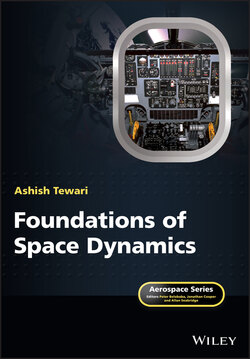Читать книгу Foundations of Space Dynamics - Ashish Tewari - Страница 38
Exercises
Оглавление1 A particle, , is launched vertically upward with velocity, , from the surface of a spherical planet of radius , rotating about the polar axis, , from west to east at the rate . The launch takes place at the latitude, , and longitude, , measured from a fixed meridian, , as shown in Fig. 2.6. Derive the expressions for the net velocity and acceleration of the particle, and resolve the vector components in a reference frame, , with its origin, , at the centre of the planet, and with one axis along the polar axis, , another along the meridian, , and the third axis, , normal to both and .Figure 2.6 Geometry for Exercise 1.
2 A point, , moves on the horizontal plane, , describing a circle of radius around the centroid, , of a cylinder of length and radius , which is rotating about the axis, , at a constant angular speed, , as shown in Fig. 2.7. The angle made by the line with the axis is , which varies with time at a constant rate, . Another point, , is on the edge of the cylinder at its base, , located at the semi‐length, , from the median section, . The radial line, , makes an angle, , with the vertical axis, , passing through (Fig. 2.7). Derive the expressions for the position, velocity, and acceleration vectors of relative to as functions of time, , assuming that when , and resolve the components in the reference frame, , with the mutually perpendicular axes, , , and , shown in Fig. 2.7.Figure 2.7 Geometry for Exercise 2.
3 Transform the equations of motion of the system of particles under mutual gravitational attraction to the following generalized coordinates, , of Lagrange:and show that they can be expressed as follows:where is the Lagrangian of the system, with and being the net kinetic and potential energies.
4 Transform the system of equations derived in Exercise 3 to a set of variables, , called the generalized momenta, defined byand show that they can be expressed in the following canonical form (Whittaker, 1988):where the net kinetic energy, , is expressed as follows:andis the Hamiltonian of the system, with being the net potential energy.
5 Referring to Exercise 4, show that if the Hamiltonian is not explicitly dependent on the time, , i.e.,then we haveor .
6 Consider four particles, each having the mass, , such that three of them are always located at the vertices of an equilateral triangle while the fourth is at its centroid. What is the angular velocity, , of the triangle?
7 Derive an expression for the gravitational potential of a thin circular ring of uniform density with mass, , radius, , and negligible cross‐sectional area, at a point located on the plane of the ring at radius from the centre, where (a) , and (b) . (Ans. (a) .)
8 Calculate the gravitational potential of a thin spherical shell of radius, and constant density per unit surface area, , at a point located at radius from the centre, where (a) , and (b) .
9 The density of a spherically symmetric mass distribution extending up to a radius is given bywhere is a constant. Find the gravitational potential for , as well as the net potential energy, if the total mass of the distribution is .
